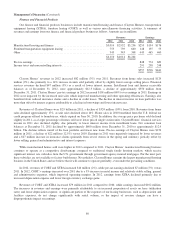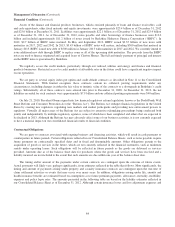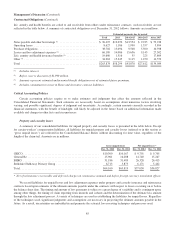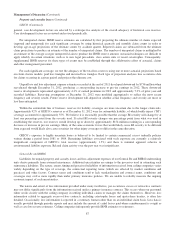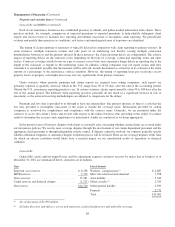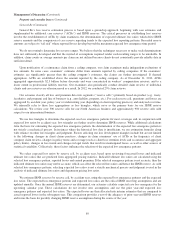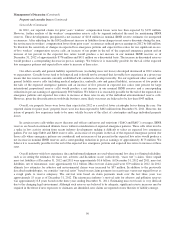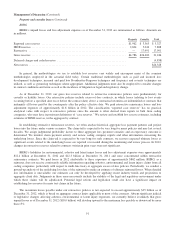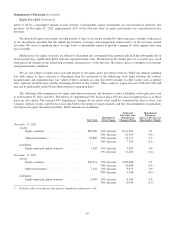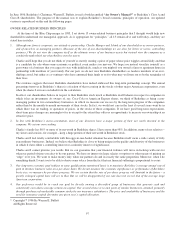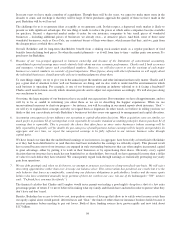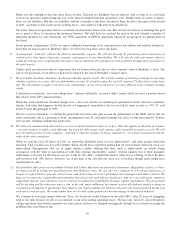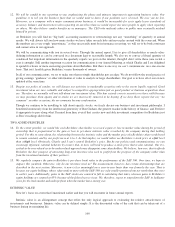Berkshire Hathaway 2012 Annual Report Download - page 92
Download and view the complete annual report
Please find page 92 of the 2012 Berkshire Hathaway annual report below. You can navigate through the pages in the report by either clicking on the pages listed below, or by using the keyword search tool below to find specific information within the annual report.Management’s Discussion (Continued)
Property and casualty losses (Continued)
General Re (Continued)
In 2012, our reported claims for prior years’ workers’ compensation losses were less than expected by $192 million.
However, further analysis of the workers’ compensation reserve cells by segment indicated the need for maintaining IBNR
reserves. These developments precipitated a net increase of $118 million in nominal IBNR reserve estimates for unreported
occurrences. After adjusting for the $142 million net increase in liabilities from changes in net reserve discounts during the year,
the net increase in workers’ compensation losses from prior years’ occurrences reduced pre-tax earnings in 2012 by $68 million.
To illustrate the sensitivity of changes in expected loss emergence patterns and expected loss ratios for our significant excess-
of-loss workers’ compensation reserve cells, an increase of ten points in the tail of the expected emergence pattern and an
increase of ten percent in the expected loss ratios would produce a net increase in our nominal IBNR reserves as of
December 31, 2012 of approximately $776 million and $411 million on a discounted basis. The increase in discounted reserves
would produce a corresponding decrease in pre-tax earnings. We believe it is reasonably possible for the tail of the expected
loss emergence patterns and expected loss ratios to increase at these rates.
Our other casualty and general liability reported losses (excluding mass tort losses) developed downward in 2012 relative
to expectations. Casualty losses tend to be long-tail and it should not be assumed that favorable loss experience in a given year
means that loss reserve amounts currently established will continue to develop favorably. For our significant other casualty and
general liability reserve cells (including medical malpractice, umbrella, auto and general liability), an increase of five points in
the tails of the expected emergence patterns and an increase of five percent in expected loss ratios (one percent for large
international proportional reserve cells) would produce a net increase in our nominal IBNR reserves and a corresponding
reduction in pre-tax earnings of approximately $943 million. We believe it is reasonably possible for the tail of the expected loss
emergence patterns and expected loss ratios to increase at these rates in any of the individual aforementioned reserve cells.
However, given the diversification in worldwide business, more likely outcomes are believed to be less than $943 million.
Overall, our property losses were lower than expected in 2012 as a result of fewer catastrophe losses during the year. Our
reported claims for prior years’ property losses were less than expected by $402 million from December 31, 2011. However, the
nature of property loss experience tends to be more volatile because of the effect of catastrophes and large individual property
losses.
In certain reserve cells within excess directors and officers and errors and omissions (“D&O and E&O”) coverages, IBNR
reserves are based on estimated ultimate losses without consideration of expected emergence patterns. These cells often involve
a spike in loss activity arising from recent industry developments making it difficult to select an expected loss emergence
pattern. For our large D&O and E&O reserve cells, an increase of ten points in the tail of the expected emergence pattern (for
those cells where emergence patterns are considered) and an increase of ten percent in the expected loss ratios would produce a
net increase in nominal IBNR reserves and a corresponding reduction in pre-tax earnings of approximately $173 million. We
believe it is reasonably possible for the tail of the expected loss emergence patterns and expected loss ratios to increase at these
rates.
Overall industry-wide loss experience data and informed judgment are used when internal loss data is of limited reliability,
such as in setting the estimates for mass tort, asbestos and hazardous waste (collectively, “mass tort”) claims. Gross unpaid
mass tort liabilities at December 31, 2012 and 2011 were approximately $1.6 billion. At December 31, 2012 and 2011, mass tort
liabilities, net of reinsurance, were approximately $1.2 billion. Mass tort net claims paid were $79 million in 2012. In 2012,
ultimate loss estimates for asbestos and environmental claims were increased by $37 million. In addition to the previously
described methodologies, we consider “survival ratios” based on net claim payments in recent years versus net unpaid losses as
a rough guide to reserve adequacy. The survival ratio based on claim payments made over the last three years was
approximately 15 years as of December 31, 2012. The reinsurance industry’s survival ratio for asbestos and pollution reserves
was approximately 8.8 years based on the three years ending December 31, 2011. Estimating mass tort losses is very difficult
due to the changing legal environment. Although such reserves are believed to be adequate, significant reserve increases may be
required in the future if new exposures or claimants are identified, new claims are reported or new theories of liability emerge.
90


